ASUS TUF Z87 Gryphon Review
by Ian Cutress on February 3, 2014 10:00 AM EST- Posted in
- Motherboards
- Asus
- Z87
- TUF
Computational Benchmarks
Readers of our motherboard review section will have noted the trend in modern motherboards to implement a form of MultiCore Enhancement / Acceleration / Turbo (read our report here) on their motherboards. This does several things – better benchmark results at stock settings (not entirely needed if overclocking is an end-user goal), at the expense of heat and temperature, but also gives in essence an automatic overclock which may be against what the user wants. Our testing methodology is ‘out-of-the-box’, with the latest public BIOS installed and XMP enabled, and thus subject to the whims of this feature. It is ultimately up to the motherboard manufacturer to take this risk – and manufacturers taking risks in the setup is something they do on every product (think C-state settings, USB priority, DPC Latency / monitoring priority, memory subtimings at JEDEC). Processor speed change is part of that risk which is clearly visible, and ultimately if no overclocking is planned, some motherboards will affect how fast that shiny new processor goes and can be an important factor in the purchase.
Point Calculations - 3D Movement Algorithm Test
The algorithms in 3DPM employ both uniform random number generation or normal distribution random number generation, and vary in various amounts of trigonometric operations, conditional statements, generation and rejection, fused operations, etc. The benchmark runs through six algorithms for a specified number of particles and steps, and calculates the speed of each algorithm, then sums them all for a final score. This is an example of a real world situation that a computational scientist may find themselves in, rather than a pure synthetic benchmark. The benchmark is also parallel between particles simulated, and we test the single thread performance as well as the multi-threaded performance.
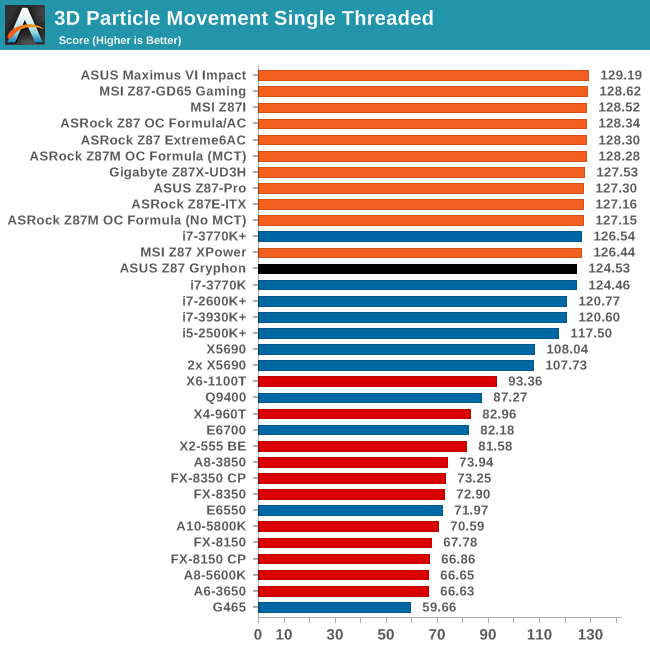
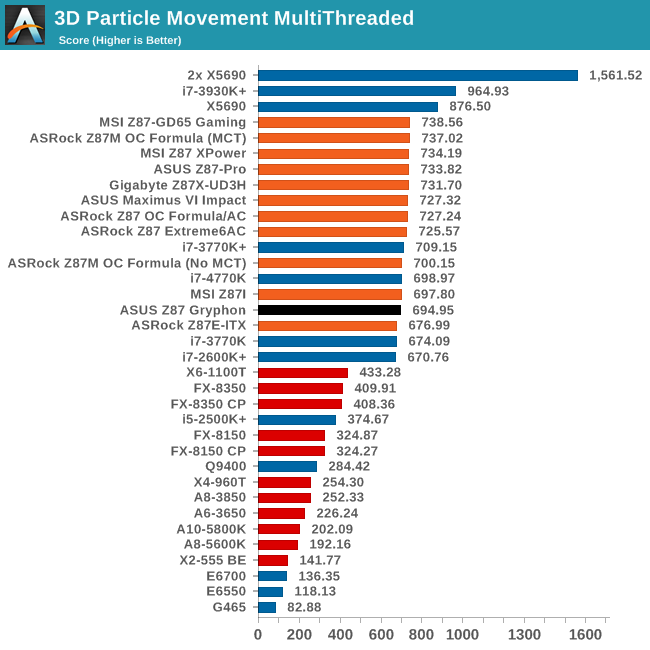
As the Gryphon does not implement MultiCore Acceleration by default, there is a small gap to the other motherboards in terms of performance, especially during multi-threading. There is a small discrepancy in terms of single thread efficiency too.
Compression - WinRAR 4.2
With 64-bit WinRAR, we compress the set of files used in the USB speed tests. WinRAR x64 3.93 attempts to use multithreading when possible, and provides as a good test for when a system has variable threaded load. WinRAR 4.2 does this a lot better! If a system has multiple speeds to invoke at different loading, the switching between those speeds will determine how well the system will do.
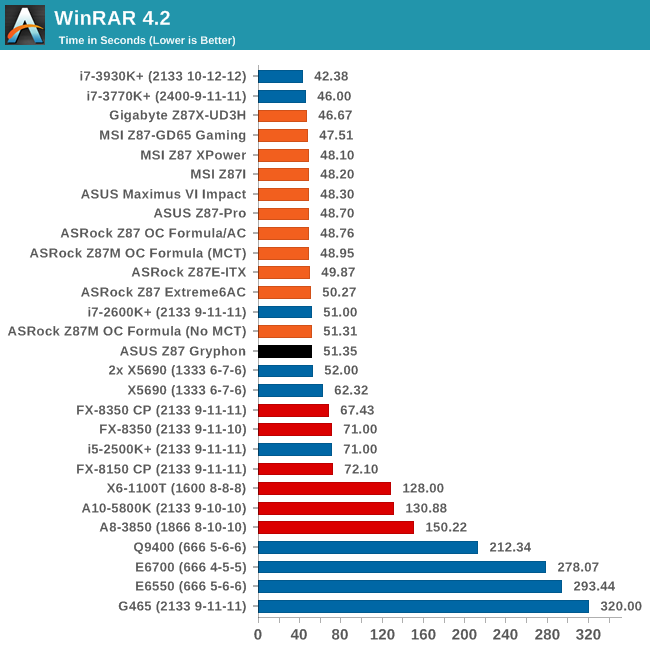
Some Z87 motherboards are in the sub-50 second range, but due to the variable threaded nature of WinRAR the Gryphon does not hit that mark.
Image Manipulation - FastStone Image Viewer 4.2
FastStone Image Viewer is a free piece of software I have been using for quite a few years now. It allows quick viewing of flat images, as well as resizing, changing color depth, adding simple text or simple filters. It also has a bulk image conversion tool, which we use here. The software currently operates only in single-thread mode, which should change in later versions of the software. For this test, we convert a series of 170 files, of various resolutions, dimensions and types (of a total size of 163MB), all to the .gif format of 640x480 dimensions.
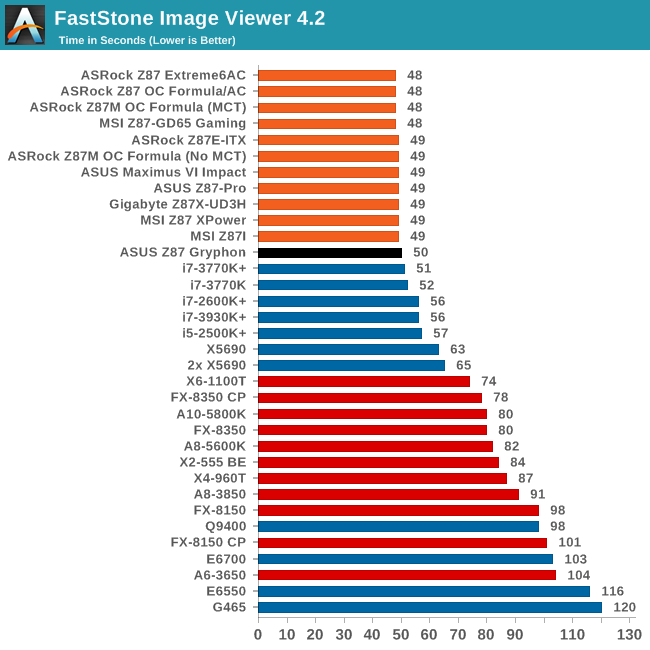
For whatever reason, the Gryphon falters slightly in our FastStone test. Either it took a little time to ramp up or was flickering in and out of Turbo during in the test.
Rendering – PovRay 3.7
The Persistence of Vision RayTracer, or PovRay, is a freeware package for as the name suggests, ray tracing. It is a pure renderer, rather than modeling software, but the latest beta version contains a handy benchmark for stressing all processing threads on a platform. We have been using this test in motherboard reviews to test memory stability at various CPU speeds to good effect – if it passes the test, the IMC in the CPU is stable for a given CPU speed. As a CPU test, it runs for approximately 2-3 minutes on high end platforms.
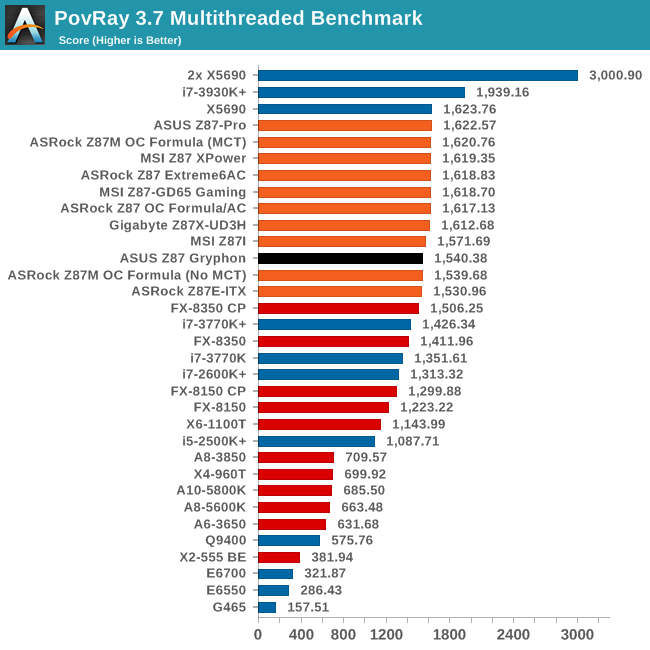
The Gryphon matches our other non-MCT motherboards in PovRay.
Video Conversion - x264 HD Benchmark
The x264 HD Benchmark uses a common HD encoding tool to process an HD MPEG2 source at 1280x720 at 3963 Kbps. This test represents a standardized result which can be compared across other reviews, and is dependent on both CPU power and memory speed. The benchmark performs a 2-pass encode, and the results shown are the average of each pass performed four times.
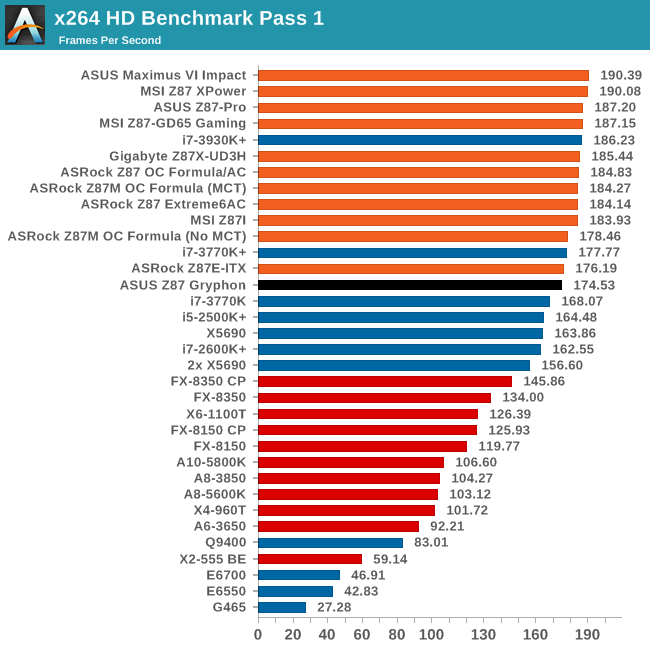
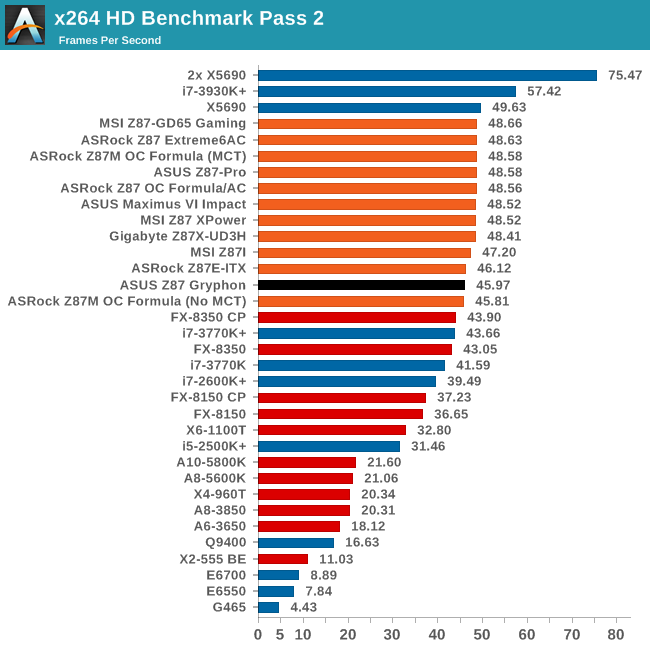
Grid Solvers - Explicit Finite Difference
For any grid of regular nodes, the simplest way to calculate the next time step is to use the values of those around it. This makes for easy mathematics and parallel simulation, as each node calculated is only dependent on the previous time step, not the nodes around it on the current calculated time step. By choosing a regular grid, we reduce the levels of memory access required for irregular grids. We test both 2D and 3D explicit finite difference simulations with 2n nodes in each dimension, using OpenMP as the threading operator in single precision. The grid is isotropic and the boundary conditions are sinks. Values are floating point, with memory cache sizes and speeds playing a part in the overall score.
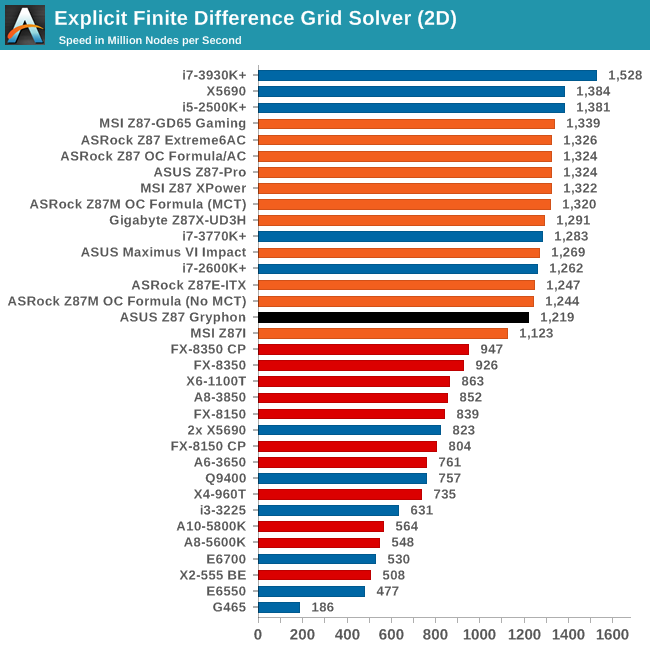
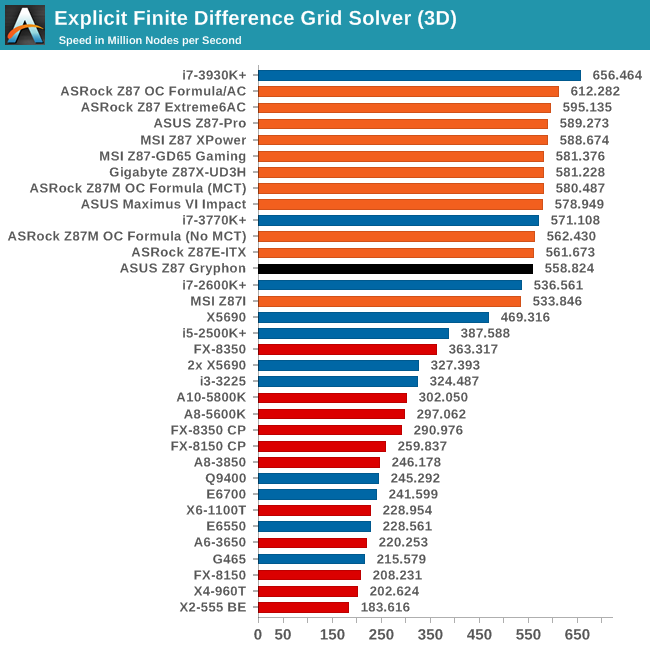
Despite no MCT, our Explicit Finite Difference testing showed preference for the Gryphon over the MSI Z87I.
Grid Solvers - Implicit Finite Difference + Alternating Direction Implicit Method
The implicit method takes a different approach to the explicit method – instead of considering one unknown in the new time step to be calculated from known elements in the previous time step, we consider that an old point can influence several new points by way of simultaneous equations. This adds to the complexity of the simulation – the grid of nodes is solved as a series of rows and columns rather than points, reducing the parallel nature of the simulation by a dimension and drastically increasing the memory requirements of each thread. The upside, as noted above, is the less stringent stability rules related to time steps and grid spacing. For this we simulate a 2D grid of 2n nodes in each dimension, using OpenMP in single precision. Again our grid is isotropic with the boundaries acting as sinks. Values are floating point, with memory cache sizes and speeds playing a part in the overall score.
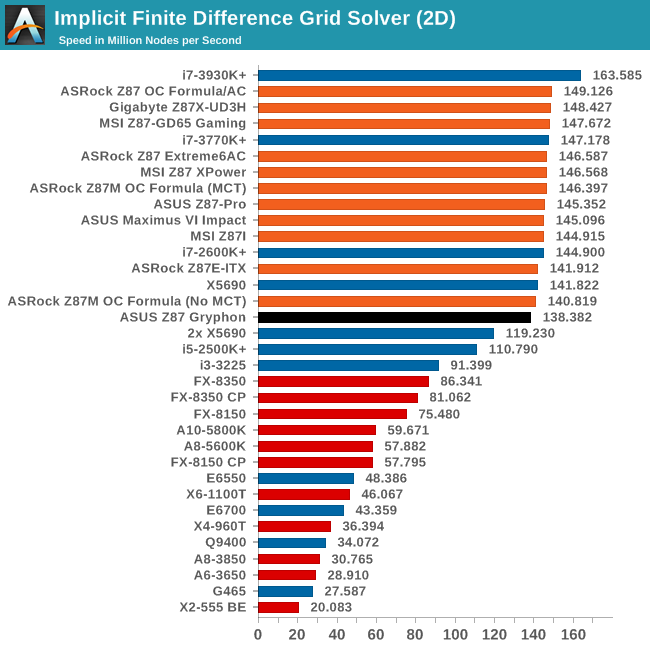
Point Calculations - n-Body Simulation
When a series of heavy mass elements are in space, they interact with each other through the force of gravity. Thus when a star cluster forms, the interaction of every large mass with every other large mass defines the speed at which these elements approach each other. When dealing with millions and billions of stars on such a large scale, the movement of each of these stars can be simulated through the physical theorems that describe the interactions. The benchmark detects whether the processor is SSE2 or SSE4 capable, and implements the relative code. We run a simulation of 10240 particles of equal mass - the output for this code is in terms of GFLOPs, and the result recorded was the peak GFLOPs value.
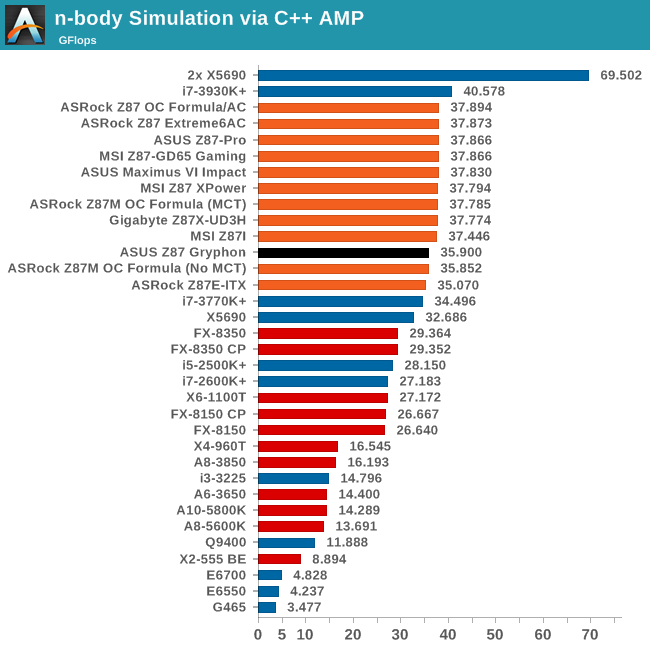










62 Comments
View All Comments
Samus - Tuesday, February 4, 2014 - link
5thaccount, did it ever occur to you the reason you saw so many Asus returns is because they are the largest motherboard manufacturer in the world, and chances are if a noobie builder is buying a board, it's going to be...Asus?Eagle007 - Tuesday, February 11, 2014 - link
I am currently in litigation with ASus over a $350 motherboard they said was defective but have not returned to me. They have spent at least $5000 not to fight the suit and not return the board. They tortured me with emails, unanswered, and chat instructions for days before issuing a RMA. Do not buy a product from them with a five year warranty as it guarantees that you will be abused by them for 5 years rather than protected from failures.Hxx - Monday, February 3, 2014 - link
lol thats so dumb is ridicoulos. Asus makes excellent board, they have always done at least in the past 10 years since ive been building my own rig. Always use them Id rather get a lower specced Asus board than a higher specced msi or gigabyte. This is not just me speaking from experience, you can read forums upon forums of people expressing similar opinions. You're either trolling or got extremely unlucky. I just sold an x38 asus p5e board for over 100 bucks on ebay if that says anything.probedb - Tuesday, February 4, 2014 - link
Odd. I've had nothing but Asus motherboards since the days of Ahtlon XP processors and none have ever missed a beat.twtech - Friday, February 7, 2014 - link
I had a bad experience with an ASUS motherboard a few builds ago - which was actually something like 6 years now. The board was overvolting the RAM, so initially it would appear stable, and then degrade after a few months and start locking up with increasing frequency. I replaced the power supply, and the RAM twice before I figured out what was actually going on.Searching for information about the issue revealed that it was actually a relatively common problem, and that the voltages displayed in the BIOS couldn't be trusted. A workaround was to manually set the RAM voltage lower, to a number that appeared to be out-of-spec. I wasn't sure how much of an offset needed to be set though, and eventually the board destroyed that set of RAM sticks too. At that point I got rid of the board.
Since then, I have been wary about purchasing another ASUS motherboard. It was probably just that model that was problematic, but having other options, it's still hard to choose to go back to a manufacturer that shipped boards with an issue as significant as that. Especially when they typically want a premium for their boards, too.
Neo123 - Sunday, February 16, 2014 - link
hi i planned to buy PC..which brand motherboard is best..in service and relablityFractinJex - Monday, February 3, 2014 - link
Both obv. not to bright....I stated until I upgrade in 4-5 years did I state the board would only last that long....noAlso this board as a 5 year warranty unlike 90% of other boards that have 3 year warranty. This is currently one of the best mATX boards available...
djshortsleeve - Wednesday, February 5, 2014 - link
No kidding, I think I have used 10-15 year old MOBOs. Rarely do they ever die.drainplugofideas - Monday, February 3, 2014 - link
Oh cool! I made nearly the same build. Cooler master n2000, i5-4670k, gtx 770, corsair MX 650.Sabresiberian - Monday, February 3, 2014 - link
I have one, too, quite happy with it. My only "complaint" is that the armor kit comes separately for a rather expensive price too, so that made what I paid pretty high all total. Still there are other premium small form factor mainboards in that price range (board+armor kit) - and with a 3 year warranty in stead of 5.The lower priced sound solution is a plus for me because I don't use mainboard sound, so the less it adds to the cost of the board the better for me. :)